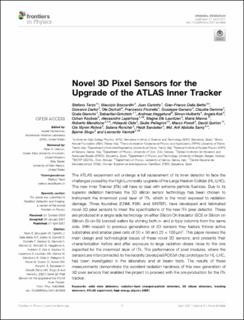| dc.contributor.author | Terzo, Stefano | |
| dc.contributor.author | Boscardin, Maurizio | |
| dc.contributor.author | Carlotto, Juan | |
| dc.contributor.author | Dalla Betta, Gian-Franco | |
| dc.contributor.author | Darbo, Giovanni | |
| dc.contributor.author | Dorholt, Ole | |
| dc.contributor.author | Ficorella, Francesco | |
| dc.contributor.author | Gariano, G | |
| dc.contributor.author | Gemme, Claudia | |
| dc.contributor.author | Giannini, Giulia | |
| dc.contributor.author | Grinstein, S | |
| dc.contributor.author | Heggelund, Andreas | |
| dc.contributor.author | Huiberts, Simon Kristian | |
| dc.contributor.author | Kok, Angela | |
| dc.contributor.author | Koybasi, Ozhan | |
| dc.contributor.author | Lapertosa, Alessandro | |
| dc.contributor.author | Lauritzen, Magne Eik | |
| dc.contributor.author | Manna, Maria | |
| dc.contributor.author | Mendicino, Roberto | |
| dc.contributor.author | Oide, Hideyuki | |
| dc.contributor.author | Pellegrini, Giulio | |
| dc.contributor.author | Povoli, Marco | |
| dc.contributor.author | Quirion, David | |
| dc.contributor.author | Røhne, Ole Myren | |
| dc.contributor.author | Ronchin, S | |
| dc.contributor.author | Sandaker, Heidi | |
| dc.contributor.author | Abdulla Samy, Md. Arif | |
| dc.contributor.author | Stugu, Bjarne Sandvik | |
| dc.contributor.author | Vannoli, Leonardo | |
| dc.date.accessioned | 2022-03-28T11:36:38Z | |
| dc.date.available | 2022-03-28T11:36:38Z | |
| dc.date.created | 2022-01-18T17:21:10Z | |
| dc.date.issued | 2021 | |
| dc.identifier.issn | 2296-424X | |
| dc.identifier.uri | https://hdl.handle.net/11250/2987975 | |
| dc.description.abstract | The ATLAS experiment will undergo a full replacement of its inner detector to face the challenges posed by the High Luminosity upgrade of the Large Hadron Collider (HL-LHC). The new Inner Tracker (ITk) will have to deal with extreme particle fluences. Due to its superior radiation hardness the 3D silicon sensor technology has been chosen to instrument the innermost pixel layer of ITk, which is the most exposed to radiation damage. Three foundries (CNM, FBK, and SINTEF), have developed and fabricated novel 3D pixel sensors to meet the specifications of the new ITk pixel detector. These are produced in a single-side technology on either Silicon On Insulator (SOI) or Silicon on Silicon (Si-on-Si) bonded wafers by etching both n- and p-type columns from the same side. With respect to previous generations of 3D sensors they feature thinner active substrates and smaller pixel cells of 50 × 50 and 25 × 100 µm2. This paper reviews the main design and technological issues of these novel 3D sensors, and presents their characterization before and after exposure to large radiation doses close to the one expected for the innermost layer of ITk. The performance of pixel modules, where the sensors are interconnected to the recently developed RD53A chip prototype for HL-LHC, has been investigated in the laboratory and at beam tests. The results of these measurements demonstrate the excellent radiation hardness of this new generation of 3D pixel sensors that enabled the project to proceed with the pre-production for the ITk tracker. | en_US |
| dc.language.iso | eng | en_US |
| dc.publisher | Frontiers | en_US |
| dc.rights | Navngivelse 4.0 Internasjonal | * |
| dc.rights.uri | http://creativecommons.org/licenses/by/4.0/deed.no | * |
| dc.title | Novel 3D Pixel Sensors for the Upgrade of the ATLAS Inner Tracker | en_US |
| dc.type | Journal article | en_US |
| dc.type | Peer reviewed | en_US |
| dc.description.version | publishedVersion | en_US |
| dc.rights.holder | Copyright 2021 The Author(s) | en_US |
| dc.source.articlenumber | 624668 | en_US |
| cristin.ispublished | true | |
| cristin.fulltext | original | |
| cristin.qualitycode | 1 | |
| dc.identifier.doi | 10.3389/fphy.2021.624668 | |
| dc.identifier.cristin | 1983997 | |
| dc.source.journal | Frontiers in Physics | en_US |
| dc.identifier.citation | Frontiers in Physics. 2021, 9, 624668. | en_US |
| dc.source.volume | 9 | en_US |

